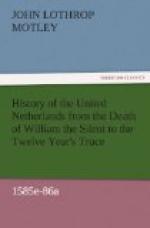It was not to be wondered at that the Queen thus situated should be cautious, when about throwing down the gauntlet to the greatest powers of the earth. Yet the commissioners from the United States were now on their way to England to propose the throwing of that gauntlet. What now was that England?
Its population was, perhaps, not greater than the numbers which dwell to-day within its capital and immediate suburbs. Its revenue was perhaps equal to the sixtieth part of the annual interest on the present national debt. Single, highly-favoured individuals, not only in England but in other countries cis- and trans-Atlantic, enjoy incomes equal to more than half the amount of Elizabeth’s annual budget. London, then containing perhaps one hundred and fifty thousand inhabitants, was hardly so imposing a town as Antwerp, and was inferior in most material respects to Paris and Lisbon. Forty-two hundred children were born every year within its precincts, and the deaths were nearly as many. In plague years, which were only too frequent, as many as twenty and even thirty thousand people had been annually swept away.
At the present epoch there are seventeen hundred births every week, and about one thousand deaths.
It is instructive to throw a glance at the character of the English people as it appeared to intelligent foreigners at that day; for the various parts of the world were not then so closely blended, nor did national colours and characteristics flow so liquidly into each other, as is the case in these days of intimate juxta-position.




